1. Introduction

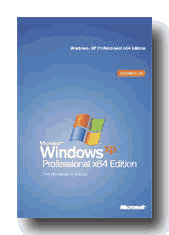
After a few unplanned delays, Microsoft has finally released
its Windows XP Professional x64 Edition. The first step into the 64-bit
world was made by AMD. AMD has been waiting 3 years for this release while
users who have AMD's x86-64 platform were only able up till now to take advantage
of the full
capabilities
with the freeware Linux operating system.
For a long time, Intel had ignored the
64-Bit architecture. It is quite interesting that, a few weeks
after the release of Intel's
CPU with x86-64 architecture, the Windows XP 64-Bit edition has also been
released. It appears as if Microsoft was holding back on its release until
the new CPU was ready.
So while the x86-64 bit architecture is gaining momentum
becoming more and more popular for its features and with newer CPUs like
the Celeron D processors expected in the near future, it is time then to
take
a deep
look into the new operating system from Microsoft which
has promised.so much.
2. System Specifications
What is this version? Does my machine support it?
This Windows release is the 64-bit version of the Windows XP
32-bit operation system. The interface is similar to Windows XP but
there are a lot of changes. Microsoft has also updated the Windows XP kernel
which is also partly based on Windows 2003. Windows x64 will
run on the AMD Athlon 64 and
AMD Opteron with AMD64, and the Intel Xeon and Intel Pentium 4 with EM64T.
Windows XP Professional 64-Bit Edition and Windows XP Professional 32-bit
differ in performance and capacity. As a result, the setup, disk space and
device driver requirements also differ. You can't install this version on
a computer that has an x86 (32 bit) architecture. Don't confuse Windows
XP Professional x64 Edition with Windows XP Professional 64-bit Edition. Windows XP
x64 is for x64 systems and Windows XP 64-bit is for Intel Itanium-based microprocessors.
Windows XP Professional x64 Edition only comes in professional
version. (From now on when we refer to Windows XP Professional we mean the
32-Bit version and when we refer to Windows XP Professional x64 Edition we
mean the 64-Bit version).
Below is a comparison table listing the setup requirements
for both Windows XP Professional and Windows XP Professional 64-Bit
Edition.
System Requirements Setup Component |
Windows XP Professional |
Windows XP Professional x64 Edition |
Minimum CPU speed |
233 megahertz (MHz) |
733 MHz |
Recommended CPU speed |
300 MHz |
N/A |
Minimum RAM |
64 MB |
256 MB |
Recommended minimum RAM |
128 MB |
512 MB |
Disk space required for Setup |
1.5 GB free |
1.5 GB free |
Let's take a look at the architectural changes. Below is a
table that describes the architectural differences between Microsoft® Windows® XP
Professional and Windows XP 64-Bit Edition.
Architectural Component |
Windows XP Professional |
Windows XP Professional x64 Edition |
Virtual memory |
4 gigabytes (GB) |
16 terabytes |
Paging file size |
64 GB |
512 terabytes |
Paged pool |
470 megabytes (MB) |
128 GB |
Non-paged pool |
256 MB |
128 GB |
System cache |
1 GB |
1 terabytes |
System Page Table Entry (PTE) |
660 MB to 900 MB |
128GB |
Physical Memory and CPU Limits |
32-Bit |
64-Bit |
Windows XP Professional |
4 GB / 1 to 2 CPUs |
128 GB / 1 to 2 CPUs |
| Windows Server 2003, Standard Edition |
4 GB / 1 to 4 CPUs |
32 GB / 1 to 4 CPUs |
Windows Server 2003, Enterprise Edition |
64 GB / 1 to 8 CPUs |
1 TB / 1 to 8 CPUs |
Windows Server 2003, Datacenter Edition |
64 GB / 8 to 32 CPUs |
1 TB / 8 to 64 CPUs |
As we can see, Windows x64 can support a lot more memory than
Windows XP 32-bit Edition. Desktop users may not see big differences, as
few users need more than 4GB of virtual memory. A big advantage we can see
is with the memory subsystem, for example with the Non-paged pool. This pool
is used by the operating system for virtual addresses, which remain in memory
and are not paged out to the hard disk. The bigger the pool, the faster the
operating system operates.
Except that, the additional (and wider) general-purpose registers
of the x64 architecture allow for significant gains in compiler efficiency
and overall application speed. With more registers, there is less need to
write out persistent data to memory, only to have to read it back a few instructions
later. Another gain with the additional, wider registers is faster function
calls. Up to four arguments can be passed in registers to a function which
is a big improvement over the x86 approach of pushing and popping arguments
off and onto the stack for every floating-point operation.
Notice: The current x64 Editions of Windows actually only use
40 bits for addressing memory, yielding an address space of 240 or
16 TB. The theoretical maximum of a full 64-Bits of address space is 264 or
16 exabytes (1.6x1019).
However, a 64-Bit system needs more memory in order to function properly. As we can see from the table below, Windows x64 kernel takes 60% more memory than Windows XP 32-Bit Edition. As a result, in order to gain the same performance level with the 32-Bit, users must upgrade their system memory.
| Required Kernel memory |
Windows XP Professional |
Windows XP 64-Bit Edition |
Total |
52120 (KB) |
31344 (KB) |
Paged |
40572 (KB) |
25396 (KB) |
Non-paged |
11548 (KB) |
5840 (KB) |
In the next page we take a better look at the operating system's
capabilities.
3. Product Overview
Why upgrade to Windows x64? Do I really need this upgrade?
What am I going to gain from this release?
Windows XP Professional x64 Edition Overview
According to Microsoft, Windows XP Professional x64 Edition
supports the latest class of Intel Itanium processors designed for users
who need to create and manipulate large amounts of complex data.
Windows XP 64-bit Edition is designed for users that require
large amounts of memory and floating point performance in areas such as mechanical
design and analysis, 3-D animation, video editing and composition, and scientific
and high-performance computing applications.
Based on the Explicitly Parallel Instruction Set Computing
(EPIC) design technology, the Intel Itanium processor can perform up to 20
operations simultaneously by using advanced compiling techniques and large
processor resources. This means that the applications can preload substantial
amounts of data into virtual memory to enable rapid access by the processor.
This reduces the time for loading data into virtual memory and the time for
seeking, reading, and writing data to storage devices and as a result, applications
to run faster and more efficiently.
· Performance Benefits
With the 64-bit version, engineers can create large, more
complex models in fields such as automobile or airplane design. This means
that engineers can use a lot of new techniques to improve product design.
Except that, 3-D animators, digital artists, and game developers, can render
more complex 3-D models faster that before. According to Microsoft, in the
areas of scientific and high performance computing, Windows XP Professional
x64 Edition will aid in oil and gas exploration, seismic analysis, computational
fluid dynamics and scientific visualization among other applications. The
hardcore gamers will experience more complex textures that require biggest
amount of memory with more image effects on the upcoming games for the 64-bit
Windows,without having to worry about the performance.
· Increased amount of memory used
In our days, there are a lot of users that are reaching the memory limits
on the 32-bit systems. Here comes the new x64 Edition to solve this problem.
With Windows XP Professional x64 Edition, the memory limit has increased
to 128 gigabytes (GB) of RAM and 16 terabytes of virtual memory. The amount
of virtual memory is going to be increased even higher in the future, as
new hardware capabilities will be available.

Virtual memory error message on Windows XP when the size you set was bigger than 4096
· Single Desktop for Technical and Business
Applications
Windows XP Professional x64 Edition will provide a single desktop for technical
and business applications, eliminating the need for technical workstation
users to maintain a PC for business applications and a separate workstation
for high-end technical applications. Most of the existing 32-bit programs
will run on the Windows XP Professional x64 Edition in comparable performance
to 32-bit Windows, hopefully it will be boosted.
Server Administrators will not have to worry about compatibility problems
when they want to setup a server with both Windows XP Professional x64 Edition
systems and 32-bit systems. Furthermore, they can manage them with the same
administrative tools.

On Windows XP Professional x64 Edition, Task Manager displays the 32-bit programs that run through WOW64 emulator with an "*32" extension.
· Same programming model
Developers with 32-bit skills will be comfortable and quickly productive
in the 64-bit Windows environment, finding it virtually identical to the
development environment for 32-bit Windows. The Microsoft Win64 application-programming
interface (API) is the same with the Microsoft Win32 API except some necessary
modifications to acquire best performance on every platform.
Finally, the feature set is the same as the previous 32-bit Windows with
the necessary modifications which includes: UI and programming models, networking,
security, graphics, multimedia, directory service, Plug and Play, and tools
features.
4. Compatibility
Am I going to have any problem with the new Windows? My old
games and programs are going to work in the new release?
There are a lot of products such as cameras, game pads, TV-tuners
that are not yet supported. As a result, it is recommended to make a research
on the
Internet to find out if the product that you want to use with the Windows
x64 is supported. In the future all the companies are going to release the
necessary drivers so if there is a device that you don’t care too must
to use it for now you can still install Windows x64
.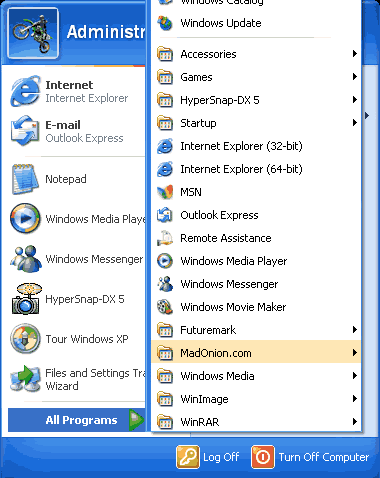
Windows XP Professional x64 Edition includes IExplorer
in both 32 and 64-Bit versions for compatibility reasons. For example, windows
update works only with the 32-Bit version for now.
We have a list with most of the companies that have already
released drivers for the Windows XP Professional x64 Edition here and
a list with programs that are not supported here.
As you can see, the list of unsupported programs is quite large
while the drivers list is quit short and a lot of users will be disappointed
after
reading them However, this
is
probably
going
to
change with a service pack/ patch or a unique release for every program.
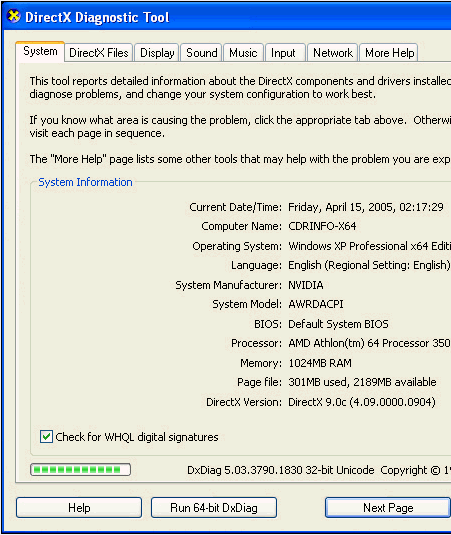
DirectX Diagnostic tool also comes in 2 versions
Last but lot least, Windows XP Professional x64 Edition does
not support 16-Bit applications and DOS applications. Users that are still
using 16-Bit applications will not be able to run them on the new operating
system. Moreover, some 32-Bit applications use 16-bit code during installation,
which means that these programs cannot be installed. Finally, all kernel
mode drivers must be 64-Bit. No support is available for 32-Bit drivers
and applications that depend on a 32-Bit kernel mode driver will not run,
even in the WOW64 subsystem.
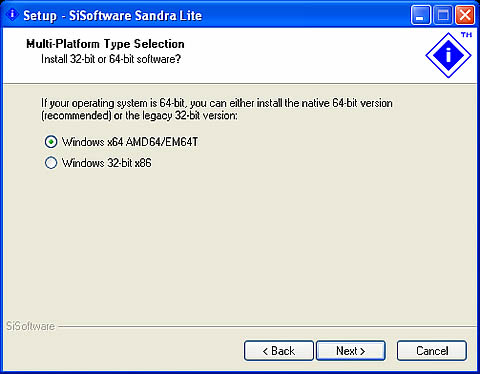
SiSoftware Sandra Installation - Let's you select on Windows XP Professional x64 Edition if you want to install the 32-Bit version or the 64-Bit.
5. Security Issues
What about security with the new Windows? What are
the differences from the previous Windows?
An important new feature in the x64 processor architecture is the Data Execution Protection (DEP) bit that controls which areas of memory can be used to execute code. While AMD and Intel have different names and slightly different implementations for this feature, the result is an enhanced layer of hardware protection against some of the most destructive worms and exploits of the past several years.
Data Execution Protection
Beginning with Windows XP Service Pack 2 (SP2) and continuing with Windows Server 2003 SP1 and Windows XP Professional x64 Edition, Windows uses DEP to prevent malicious code from being able to execute, even when a buffer overrun occurs. Even without a processor that supports DEP in hardware, Windows is able to detect code running from memory locations that it should not.
With the introduction of x64 processors, both AMD and Intel added hardware support for DEP. The processor sets the No Execute bit (for AMD processors) or the Execute Disable bit (for Intel processors) on all entries in the memory address table that are for data only and should not be executed. If code attempts to execute from within an area of memory marked as data only, Windows will raise a status access violation exception and terminate the process.
While DEP is by no means a substitute for a well-designed and implemented anti-virus and anti-malware deployment in any organization, it is an important additional layer of protection that would have prevented the spread of the MSBlaster worm had it been widely implemented at the time.
The x64 versions of Windows also support Microsoft's PatchGuard
technology that prevents non-Microsoft originated programs from patching
the Windows kernel. This technology, available only on Windows x64 Editions,
prevents kernel mode drivers from extending or replacing kernel services
including system service dispatch tables, the interrupt descriptor table
(IDT), and the global descriptor table (GDT). Third-party software is also
prevented from allocating kernel stacks or patching any part of the kernel.
6. Gaming Experience
What about playing games on the Windows XP Professional
x64 Edition? Are my old games going to work with this release? What about
the new upcoming games? Are they going to be different from the Windows XP
Professional version?
On the gaming side, some users will be surprised to learn that
some games may not work correctly under Windows XP Professional x64 Edition.
For example, games that are using Starforce copy protection cannot be installed
because the driver for the copy protection is present only as a 32-bit version.
But games that will be optimized for the Windows XP Professional
x64 Edition are coming fast. The first game has already been released.
It is the Shadow
Ops: Red Mercury. The changes are going to be a lot because of the benefits
of the 64-Bit technology that we discussed at the beginning (vast memory
space and advanced multi-media processing capabilities). From AMD.com we
see a press release saying that "...With the 64-Bit version of Shadow
Ops: Red Mercury, gamers will notice larger and more detailed areas to explore,
breakthrough artificial intelligence (AI), and never-before-seen textures
that compel players to gawk in amazement". Atari.com has
also released this announcement: "The 64-Bit
version of the game will be included with the 32-Bit version and will allow
for improved
textures, better image quality, faster game performance and an enhanced gameplay
experience.... Gamers who install the 64-Bit version of Shadow
Ops: Red Mercury, get access to the 64-Bit only level of detail, with mind-blowing
texture quality, enormous map sizes and amazingly enhanced artificial intelligence,
creating an exceptional game play experience." So,
you can expect differences in the quality of the textures of the
ground,
the gun, the shadows of the characters, more objects in the environment or
more detailed, differences in lighting and shadow enhacements.We have a photo
to compare the changes.
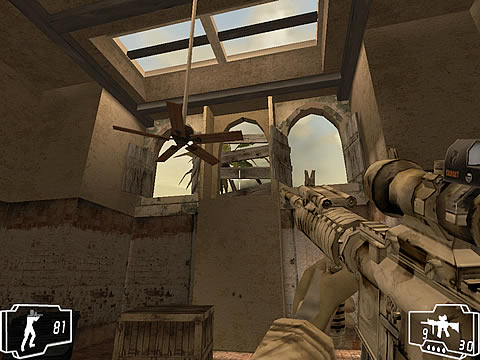
Shadow Ops: Red Mercury 32-Bit version
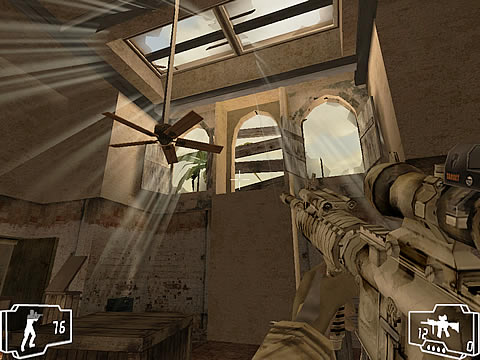
Shadow Ops: Red Mercury 64-Bit version
You can take a look at some more photos with the changes from the 32-Bit to 64-Bit version that we found on the game homepage here.
Comparing this game with other games like half life 2 and doom
3, we can accept that the 64-Bit version of shadow ops hasn't anything
better to present in the graphics department. But don't be misled
by the supposed changes
from the 32-bit to the 64-bit versions. The result is still poor and not
as good as on other successful 32-bit games like half life 2, far cry and
doom 3.
Unfortunately, the game does not support any benchmarking tool
for now and FRAPS (the program that we use to count frames per second in
games
that don't support benchmark options) does not work correctly on
Windows XP Professional x64 Edition with the 64-Bit version of Shadow Ops.
As soon as we find a way to run a benchmark test on this game, we will
update this review.
Another game that is expected to release a 64-Bit patch is Far
Cry. Far cry is a very popular, awesome First Person Shooter (FPS)
based on a last generation 3D engine named CryEngine. Real-time editing,
bump-mapping,
static lights, network system, integrated physics system, shaders, shadows
and a dynamic music system are just some of the state of-the-art features
that CryEngine offers. According to AMD.com, "AMD64
technology enables Far Cry's next-generation engine to push the threshold
of action gaming with unprecedented AI, Polybump™ mapping, advanced
environmental physics, destructible terrain, dynamic lighting, motion-capture
animation, and total surround sound. Far Cry's unbelievable 800-meter
draw distance redefines the idea of long-range gameplay." More
information can be found here.
7. Availability And Price
Are there a lot of 64-bit choices out there? Is the
home user able to find 64-bit
processors easily? How much more will it cost compared with an x86 processor?
AMD and Intel offer a broad range of x64 processors, and both
original equipment manufacturers (OEMs) and system builders are shipping
x64 systems that range from enthusiast desktops and laptop machines all the
way up to 4-way multiprocessor server machines. With the release of the x64
Editions of Windows, 64-bit is ready to become the mainstream of computing.
By the end of 2005, Microsoft hopes that all new server class
machines shipping will be 64-bit. And at the end of 2006, the majority of
new PCs and workstations will also be 64-bit.
The current price of x86 and x64 processors is going to be
essentially identical, making the choice of an x64-capable processor the
clear preference. Still, the lower end consumer x86 processors and computers
are significantly cheaper than x64 machines and will continue to be the main
choice for most cost-conscious consumers.
After reading the answers to the questions posed, if you are
satisfied with the result and with the research you may have done, you can
continue
to install Windows x64.
8. Windows Installation
If you are familiar with the installation of Windows XP PROFFESIONAL or
HOME versions, then you will not have any problems installing this version.
(You can buy Windows XP Professional x64 Edition from Microsoft.com.
For those who already have an x64 computer running Windows XP Professional
(32-Bit),
they can exchange their 32-Bit
edition of Windows XP for Windows XP Professional x64 Edition.)
· Phase 1
You have 2 options on how you are going to install XP Professional
x64 Edition.
1. Install Windows x64 over an existing operating system.
As a result, you will not be able to recover your previous operating system.
The previous WINDOWS folder will be deleted and you will lose all registry
values. Nothing else is going to be deleted. (Although your previous programs
will not be lost, there is a possibility that they will not function correctly).
2. Make a new partition or use a second Hard Disk Drive to install Windows
x64.
This option is recommended. With this option you will lose only 2GB of
disk space, the previous operating system will still be functional. You will
have the ability to select with which operating system you want to start.
Before continuing with the installation, check the List with the devices that
are supported at this time. Also, if you have a small computer system interface
(SCSI) drive or a raid controller, you will need 64-Bit Drivers. Check our
List will the current drivers that are available.
· Phase 2
First, Make sure that you have “Boot From CD” Function enabled
in the BIOS settings.
In order to do this, press the “Delete” button (or the respective
key for your BIOS setup) during the Power-On Self Test (POST). In the Boot
Sequence menu select your
CD/DVD-Rom
device as the “First BOOT Device” (if there is an option ”Boot
From CD”, enable it). Insert the Windows x64 CD-Rom and restart your
computer.
After the POST test, the prompt "Press any key to boot from CD" will
appear, press any key at the prompt, and the installation will begin. (If you
want to install a SCSI drive or a raid controller, insert the floppy disk you
have created with the 64-Bit drivers).
When the Installation menu appears, select the hard disk on which you
want to install Windows x64. The installation will start after the necessary
restart.
After the installation, when you logon to Windows, you should see this
screen:
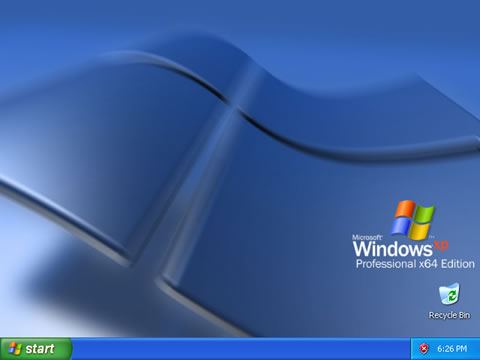
The next step, is drivers installation.
9. Drivers Installation
Most probably after the OS installation, the system will not
recognize some of your hardware components and in the device manager
tab, you will see something
like this:
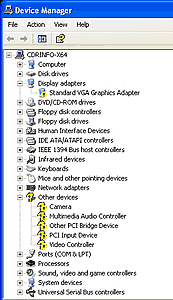
Device Manager Window
Don't panic. We are going to solve this problem.
Windows XP Professional x64 Edition requires the installation
of 64-Bit drivers only. You cannot install 32-Bit drivers. There are some
device drivers that have
been modified to allow installation of 64-Bit and 32-Bit drivers from the
same .inf file. This is necessary to avoid installing wrong drivers under
the wrong platform.
When installing drivers for the Windows XP Professional x64
Edition, be sure that the provider says that the driver works on “Windows
XP Professional x64 Edition” and
not on the “Microsoft Windows XP” or “Windows XP Professional”.
Some users will probably remember a time when Windows
2000 had exactly the same problem after their initial release when the
operating system didn’t
recognize a whole lot of hardware. We have already mentioned our list of
companies that have released drivers for their products which is also
posted in
our forums. Click here to
see the full list.
You must install drivers in the following order, in order
to install the drivers correctly and to avoid conflicts with other drivers.
After any
install
you make, it is recommended you restart your computer.
1. Motherboard Drivers
2. Graphic Card Drivers
3. Sound Card Drivers
4. Any other device drivers
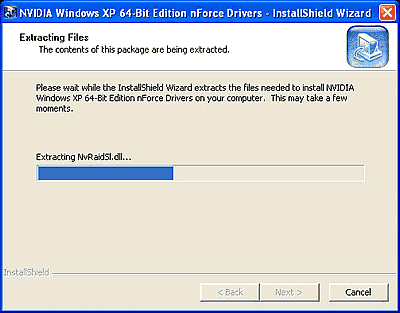
Driver Installation procedure
After the driver installation, we are ready to test our system.
In the next page you will find information about the computer that we
used to run all the tests on and what programs we used.
10. Test System
The system that we ran all the tests on is listed
below. For each operating system, we used a separate partition with the
same capacity (15GB). We decided to use an AMD processor because in contrast
to Intel's Itanium, AMD's 64-bit architecture can handle 32-bit code
very fast, which makes for a smooth transition to 64-bit computing.
System Specifications |
| Processor: |
AMD 3500+ S939 |
| Cooler: |
Stock AMD Heatsink-Fan |
| Case: |
CoolerMaster Stacker |
| VGA Card: |
Sapphire X800 XL 256MB |
| Motherboard: |
Gigabyte GA-kbnxp-9 |
| Memory: |
2x512MB Kingston CS 2,5 PC-3700 Memory |
| Hard Disk Drive: |
WD800JD SATA 120GB 7200RPM & Hitachi SATA 120GB 7200RPM |
| DVD-RW: |
Pioneer DVR-109 |
| PowerSupply: |
Tagan 480Watt |
| Extras: |
DirectX v9.0c |

Benchmarking Software
Below is a list with all the games and the programs
we used for this review. (Note that AA: AntiAliasing and
AF: Antistrophic) We ran every game and program both on Windows XP Professional
and Windows XP Professional x64 Edition. Some programs were available
in 64-bit versions. For those programs, we ran the 64-bit version on
Windows XP Professional x64 Edition and the 32-bit version on Windows
XP Professional
with the same settings.
| Games |
Name & Version |
Resolution |
Settings |
Farcry (v1.3) |
800x600 |
Very high quality, 6AA, 12AF |
1024x768 |
1280x1024 |
1600x1200 |
Colin McRae Rally 2005 Demo (v.1.0) |
800x600 |
Very high quality, 6AA, 12AF , z-depth 24 |
1024x768 |
1280x1024 |
1600x1200 |
| Half Life 2 - Video Stress Test |
800x600 |
Very high quality, 6AA, 16AF
|
1024x768 |
1280x1024 |
1600x1200 |
Programs |
Name & Version
|
Resolution |
Settings |
3DMark05 (v.1.2.0)
3DMark03 (v.3.6.0) |
1280x1024 |
6 AA, Filter mode AF, Max AF 16x |
Pcmark04 (v.1.3.0) |
N/A |
N/A |
SiSoftware Sandra 2005 SR1 (v.10.50) (32-bit & 64-bit) |
N/A |
N/A |
ScienceMark 2 (v.21/03/2005)
(32-bit & 64-bit) |
N/A |
N/A |
Pov-Ray (v.3.6.1a)
(32-bit & 64-bit) |
1280x1024 |
0.3 AA |
11. Game Benchmarks - Far Cry

 You are Jack Carver running your own boat charter business in beautiful Micronesia. With a past best left behind you, you'll be focusing on your present assignment: escorting an ambitious journalist named Valerie Cortez to the Island of Cabatu. It seems like a piece of cake, but you'll soon learn: paradise can be hell.
You are Jack Carver running your own boat charter business in beautiful Micronesia. With a past best left behind you, you'll be focusing on your present assignment: escorting an ambitious journalist named Valerie Cortez to the Island of Cabatu. It seems like a piece of cake, but you'll soon learn: paradise can be hell.
Farcry is an awesome First Person Shooter (FPS) based on a last generation 3D engine named as CryEngine. Real-time editing, bump-mapping, static lights, network system, integrated physics system, shaders, shadows and a dynamic music system are just some of the state of-the-art features that the CryEngine offers.
A great advantage and strong point of the CryEngine is its physics system which supports character inverse kinematics, vehicles, rigid bodies, liquid, rag doll, cloth and body effects. All physics seem to be very realistic and you never get bored when facing enemies, since character models have multiple animations that blend in believable ways.
With an integrated shader system and a massive terrain which maximizes
the view distance to 2km, these features make Farcry a perfect action game and
also a referable benchmark to speak of.
- Benchmark Settings
For this game we recorded a custom demo from the start of the Rebellion
stage. We chose an indoor scene in order to avoid getting the CPU bound effect. This will result in slightly higher results since it is also less
GPU intensive

The latest patch (1.3) was used for our tests which updates the
game's graphics engine to use the 3.0 Shader model. This option is only supported
for the 6800 series.
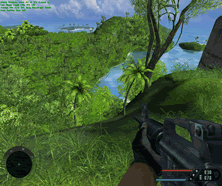
The resolutions we ran the demo under, are as follows: 800x600,1024x768,
1280x1024 and 1600x1200. The tests was committed with Anti Aliasing at 6x (AA)
and Anisotropic Filtering at 12x (AF). All tests were taken with Jack's flashlight on,
to increase
the game's demands from the graphics cards and with ai_update_interval set
to zero so that the results are subjective.
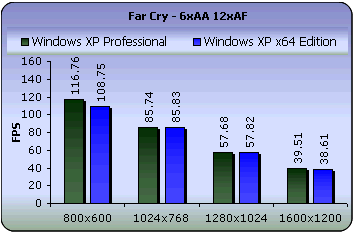
In this game, we notice a performance drop of around 7% with
Windows XP x64 Edition while running at the resolution of 800x600. This
shows that the 32-Bit
emulator for the Windows XP Professional x64 Edition (WOW64) cannot reach the
performance of Windows XP Professional. We were happy to see that with the
other
resolutions, the performance difference was less than 1%.
12. Game Benchmarks - Colin McRae 2005

For all you racing fans out there, this test is for you and will represent the Racing game category in our benchmarks.
 From
the graphics point of view the first thing you'll notice in the game is the
excellent amount detail of your racing car. High resolution textures on the
car and lighting make it quite impressive. All the eye candy such as the
sun reflection in the virtual camera are still the same as the older CM versions
but motion blur has been added when your card hits something hard which will
happen most often if you're new to the racing simulation world.
From
the graphics point of view the first thing you'll notice in the game is the
excellent amount detail of your racing car. High resolution textures on the
car and lighting make it quite impressive. All the eye candy such as the
sun reflection in the virtual camera are still the same as the older CM versions
but motion blur has been added when your card hits something hard which will
happen most often if you're new to the racing simulation world.
To measure performance on the game we used fraps to get the average fps of the whole 8th stage of UK which is actually the only stage you get to play on the demo.
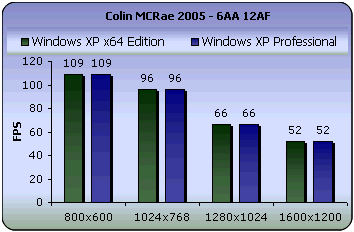
However, with Colin MCRae 2005, we clocked exacly the same
frames per second at each resolution. WOW64 did a great job with this
game showing
that we could expect to see the same performance with some games and maybe
even a little better.
13. Game Benchmarks - Half Life 2
Half life 2 is no doubt the most anticipated pc game of all times. Gamers keeping the excellence of Half Life 1 in their mind as well as the remarkable E3 demo preview, have been anxiously waiting for the much delayed release of HL2.
 Regarding the storyline, the player again picks up the crowbar of research scientist Gordon Freeman, who finds himself on an alien-infested Earth being picked to the bone, its resources depleted, its populace dwindling. Freeman is thrust into the unenviable role of rescuing the world from the wrong he unleashed back at Black Mesa. And a lot of people he cares about are counting on him.
Regarding the storyline, the player again picks up the crowbar of research scientist Gordon Freeman, who finds himself on an alien-infested Earth being picked to the bone, its resources depleted, its populace dwindling. Freeman is thrust into the unenviable role of rescuing the world from the wrong he unleashed back at Black Mesa. And a lot of people he cares about are counting on him.
Characters - Advanced facial animation system delivers the most sophisticated in-game characters ever seen. With 40 distinct facial "muscles," human characters convey the full array of human emotion, and respond to the player with fluidity and intelligence.
 Physics - From pebbles to water to 2-ton trucks respond as expected, as they obey the laws of mass, friction, gravity, and buoyancy.
Physics - From pebbles to water to 2-ton trucks respond as expected, as they obey the laws of mass, friction, gravity, and buoyancy.
Graphics - Source's shader-based renderer, like the one
used at Pixar to create movies such as Toy Story® and Monster's, Inc.®,
creates the most beautiful and realistic environments ever seen in a video
game.
 AI - Neither friends nor enemies charge blindly into the fray. They can assess threats, navigate tricky terrain, and fashion weapons from whatever is at hand.
AI - Neither friends nor enemies charge blindly into the fray. They can assess threats, navigate tricky terrain, and fashion weapons from whatever is at hand.
To measure performance we used the Video Stress Test(VST) that is available in the CounterStrike:Source beta available through Steam. We set all the details to the highest level and each time changed the resolution from 800x600 up to 1600x1200.
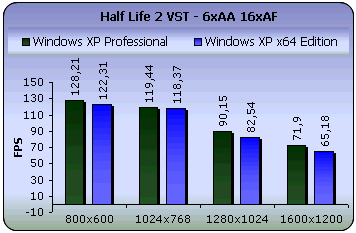
As we can see, Windows XP Professional has a performance lead
with this 32-Bit game, up to 5% at 800x600 resolution and as the resolution
increases, the performance difference increases up to 9% at the 1600x120
resolution. The Windows x64 emulator, WOW64 is not able to run this game
at the same
performance as Windows XP Professional for the same reasons that it was
not able to run the Far Cry.
At this point, we will continue with some application tests
to see if we have any performance changes when we run
the same 32-Bit versions on each of the Windows versions and then to see
the boost in performance when we use a 64-bit version of an application with
Windows XP x64
against
the 32-Bit
version with Windows XP Professional.
14. Application Benchmarks - 3DMark2003
 3D Mark is a widely used and accepted benchmark that stresses the DirectX performance of a VGA card. A very strong point of 3DMark is that it's VGA card measuring is does not require any CPU power. So the resulting fps are a good reference a VGA card's rendering performance. For testing the performance of each card we used the 4 game benchmarks 3DMark has.
3D Mark is a widely used and accepted benchmark that stresses the DirectX performance of a VGA card. A very strong point of 3DMark is that it's VGA card measuring is does not require any CPU power. So the resulting fps are a good reference a VGA card's rendering performance. For testing the performance of each card we used the 4 game benchmarks 3DMark has.
3Dmark03 also includes sound and CPU tests as well as some other feature tests.
- Game Test 1 - Wings of Fury (DX7)

This test is a combat flight simulator written for older
hardware (DirectX 7). Particles are used a lot in this test - smoke and vapor
trails, flak and gunfire, and explosions are produced using point sprites
and quads.
- Game Test 2 - Battle of Proxycon (DX8)
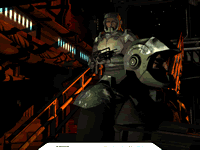
This test is a simulation of first person shooter game types. 1.1 and 1.4 Vertex shaders are widely used since all character models are skinned using vertex shaders.This makes this test a good vertex shader comparison for VGA cards.
- Game Test 3 - Trolls' Lair (DX8)
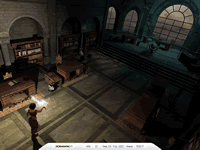
This test should be the favorite of all RPG lovers. It is a cut scene of a female warrior facing two malicious trolls. Again the same vertex and pixel processing is used as in game test 2.
This test also uses post-processing effects, such as Depth of Field and Bloom effects which are widely used in today's game cut scene sequences.
- Game Test 4 - Mother Nature (DX9)
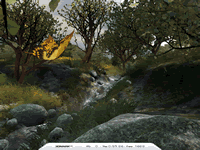
Mother nature represents the level of effects and realism that are possible using 2.0 vertex and pixel shaders, plus some other features that DirectX 9 offers.
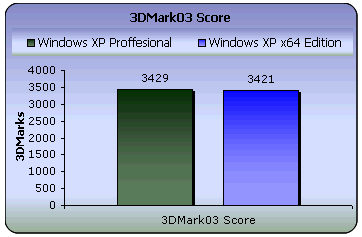
Windows XP x64 does a really good job in this test. The difference
is barely noticeable. Below are the full games results. The results
must be considered as identical because of the fact that 3DMark has a tolerance
of ±2% and so the difference in the FPS could have swung either way.
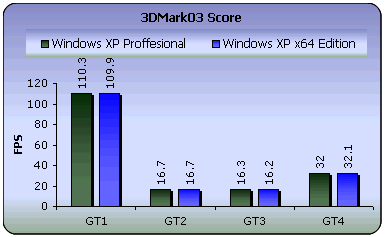
15. Application Benchmarks - 3DMark2005
 With 3DMark05, Futuremark continues the tradition in its benchmarking software by providing a state-of-the-art Microsoft ® DirectX ® 9 3D performance benchmark.
With 3DMark05, Futuremark continues the tradition in its benchmarking software by providing a state-of-the-art Microsoft ® DirectX ® 9 3D performance benchmark.
3DMark05 is an all new 3DMark version taking the most out of Microsoft's DirectX 9. The previous version 3DMark03, did a nice introduction into this level of technology. However 3DMark03 used DirectX 9 specific features in a limited manner, because fully supporting  hardware was rare at the time of its launch. In contrast, 3DMark05 requires DirectX 9 hardware with full support for at least Shader Model 2, and takes shader usage to never before seen levels.
hardware was rare at the time of its launch. In contrast, 3DMark05 requires DirectX 9 hardware with full support for at least Shader Model 2, and takes shader usage to never before seen levels.
Just like its predecessors, 3DMark05's point system is set so that at the moment of release, the high-end VGA cards available in stores can only score around 5000 3DMarks, whereas the worst card that meets the programs requirements yields a score of 1000.
Game Test 1 -Return to Proxycon
Being the sequel to the "Battle of Proxycon" from 3DMark03, in "Return to Proxycon" we're once again set in space and the battle continues as space pirates invade a cargo ship in order to take control of its valuable cargo.

This test, tries to simulate a future first-person shooter game with all the high details that entails. The dynamic shadows, high-detailed environment and advanced lighting techniques ensure that under normal circumstances, no recent card can run it with decent frame rates.
Game Test 2 - Firefly Forest
A forest gets filled with magic fireflies in the night. The moon is nearly full, illuminating the forest with a bluish faint light. The magic fireflies have flickering bright green lights that playfully move around the forest.
This scene is a nice example of a smaller scale outdoor scene with rich vegetation. Immediate visibility is not so far, and there is a skybox surrounding the whole scene.
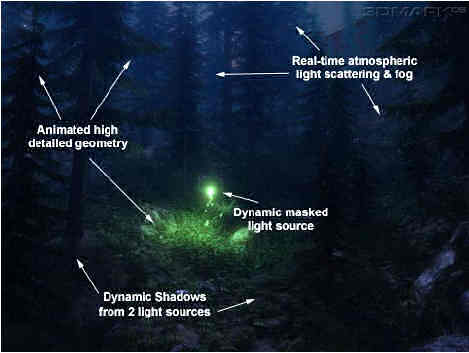
A large number of trees with their branches swinging separately, and dense vegetation being dynamically distributed according to the camera movements, make this test the most demanding of the three.
Game Test 3 - Canyon Flight
A Jules Verne type airship flies through a canyon guarded by a dangerous sea monster. The airmen defend their ship using heavy cannons, but these seem to have no effect on the huge sea monster. Finally the crew manages a narrow escape using the "last resort" afterburners of the airship.
This scene is fairly complex with large areas of water reflecting the high canyon walls. The water actually is one of the key points of interest in this scene. The water not only does realistic looking reflections and refractions, it has a depth fog, making the sea monster swimming under the airship actually look deep down in the water. The air in this scene also uses
a volumetric fog, making distant cliffs of the canyon really look far away.

Final Score
3DMarks on 3DMark05 are now calculated by the following formula:
(Game Test 1 * Game Test 2 * Game Test 3)^0.33 * 250
Below we have the Total score for 3DMark 2005
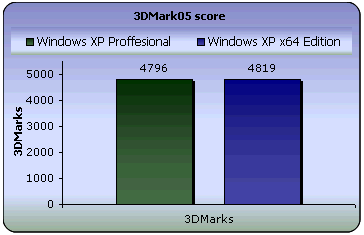
Just as with 3DMark 2003, this test shows similar
performance scores for both Windows versions. However, with Windows XP
x64, we have a performance lead of
approximately 3% allround.
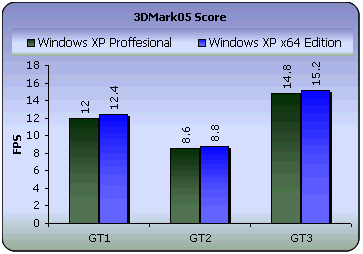
16. Application Benchmarks - PCMark04
PCMark04 is an application-based benchmark and a premium tool for measuring overall PC performance. It uses portions of real applications instead of including very large applications or using specifically created code. This allows PCMark04 to be a smaller installation as well as to report very accurate results. As far as possible, PCMark04 uses public domain applications whose source code can be freely examined by any user.
PCMark04 includes 4 categorized suites for benchmarking your computer. These include a CPU, Graphics, Memory and a Hard Disk Drive benchmark.

We ran all the test for both operating systems.Here are the extended results:
CPU |
Windows XP Professional |
Windows XP Professional x64 Edition |
File Compression |
3.261 MB/s |
3.253 MB/s |
File Encryption |
34.061 MB/s |
34.049 MB/s |
File Decompression |
26.964 MB/s |
26.883 MB/s |
Image Processing |
13.465 MPixels/s |
13.459 MPixels/s |
Grammar Check |
5.764 KB/s |
5.789 KB/s |
File Decryption |
67.665 MB/s |
67.875 MB/s |
Audio Conversion |
2928.096 KB/s |
2914.430 KB/s |
WMV Video Compression |
50.124 FPS |
50.331 FPS |
DivX Video Compression |
56.318 FPS |
56.281 FPS |
Memory Tests |
Windows XP Professional |
Windows XP Professional x64 Edition |
Raw Block Read - 8 MB |
2318.248 MB/s |
2276.145 MB/s |
Raw Block Read - 4 MB |
2392.298 MB/s |
2278.329 MB/s |
Raw Block Read - 192 KB |
10882.191 MB/s |
10585.657 MB/s |
Raw Block Read - 4 KB |
28256.068 MB/s |
28213.992 MB/s |
Raw Block Write - 8 MB |
1834.620 MB/s |
1831.225 MB/s |
Raw Block Write - 4 MB |
1834.457 MB/s |
1830.945 MB/s |
Raw Block Write - 192 KB |
7039.960 MB/s |
7011.978 MB/s |
Raw Block Write - 4 KB |
21489.963 MB/s |
21460.324 MB/s |
Raw Block Copy - 8 MB |
886.992 MB/s |
868.694 MB/s |
Raw Block Copy - 4 MB |
902.066 MB/s |
870.279 MB/s |
Raw Block Copy - 192 KB |
4590.229 MB/s |
4386.226 MB/s |
Raw Block Copy - 4 KB |
11460.180 MB/s |
11444.274 MB/s |
Random Access - 8 MB |
2178.573 MB/s |
2161.878 MB/s |
Random Access - 4 MB |
2170.234 MB/s |
2160.326 MB/s |
Random Access - 192 KB |
6810.752 MB/s |
6798.934 MB/s |
Random Access - 4 KB |
14459.060 MB/s |
14439.047 MB/s |
Graphics Tests |
Windows XP Professional |
Windows XP Professional x64 Edition |
Transparent Windows |
2299.610 Windows/s |
2070.971 Windows/s |
Graphics Memory - 16 lines |
3168.186 FPS |
3138.774 FPS |
Graphics Memory - 32 lines |
3022.391 FPS |
2759.852 FPS |
3D - Fill Rate Single Texturing |
2525.639 MTexels/s |
2529.406 MTexels/s |
3D - Fill Rate Multi texturing |
4095.767 MTexels/s |
4099.160 MTexels/s |
3D - Polygon Throughput Single Light |
58.184 MTriangles/s |
58.999 MTriangles/s |
3D - Polygon Throughput Multiple Lights |
20.253 MTriangles/s |
21.281 MTriangles/s |
| HDD Tests |
Windows XP Professional |
Windows XP Professional x64 Edition |
| XP Startup |
8.891 MB/s |
9.185 MB/s |
| Application Loading |
6.708 MB/s |
7.677 MB/s |
| File copying |
36.749 MB/s |
36.869 MB/s |
| General HDD Usage |
5.611 MB/s |
6.035 MB/s |
The difference is unnoticeable with most of the PCMark04 tests.
Once again, the differences in the graphics tests puts Windows XP in
1st place because of the WOW64 emulator. Take a look at the results for
the transparent
windows test under the Graphics suite. In this test, 10 windows are drawn on-screen
and then faded in and out. The results then record the average number
of windows drawn per second.
In the memory and CPU tests, the differences is also not noticeable. With
the HDD tests, we notice a performance increase with Windows XP Professional
x64
Edition.
This is because of the better memory handling of Windows XP Professional
x64 Edition which we have already discussed.
17. Application Benchmarks - SiSoftware Sandra 2004
SiSoftware Sandra 2004
 SiSoftware Sandra (the System ANalyzer, Diagnostic and Reporting Assistant) is an information & diagnostic utility. It should provide most of the information (including undocumented) you need to know about your hardware, software and other devices whether hardware or software.
SiSoftware Sandra (the System ANalyzer, Diagnostic and Reporting Assistant) is an information & diagnostic utility. It should provide most of the information (including undocumented) you need to know about your hardware, software and other devices whether hardware or software.
CPU Arithmetic Benchmark
Sandra's CPU arithmetic benchmark suite uses 2 famous benchmarks
(Dhrystone and Whetstone) for stress testing the processor. Also it includes
a new version of the Whetstone test that makes use of a processor's
SSE2 instructions to show the performance boost an application might gain
should it be optimized for SSE2. Unfortunately this does not always represent
a true real-life performance, but is useful to compare the speed of various
CPUs.
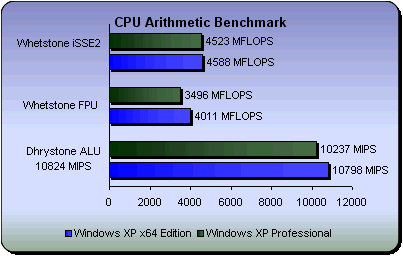
The 64-Bit performance benefits in this test show only 65 iterations
per second more with the SSE2 instructions and about 500 more
for the Whetstone FPU (floating point) and Dhrystone (arithmetic)
benchmark.
CPU Multimedia Benchmark
This test involves the generation of Mandelbrot Set fractals that are used to realistically describe and generate natural objects such as mountains or clouds. By using various multi-media extensions MMX, 3DNow! and SSE(2/3) better performance is achieved.
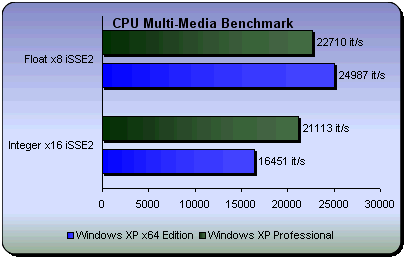
Here the benchmark takes advantage of the x8 SSE2 instructions
for floating points and x16 SSE2 for integers, we managed to get about 5000
iterations per second less (about 23%) with integers
and 2000 iterations more (about 9%) with floating point.
Memory Bandwidth Benchmark
This tests examines how your memory sub-system compares to other systems with the same or similar memory. The benchmark is based on the well-known STREAM memory bandwidth benchmark.(The main difference is that STREAM 2.0 uses static data (about 12M) but SiSoftware Sandra uses dynamic data (around
40-60% of physical system RAM). )
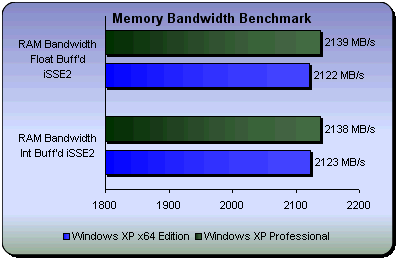
Although this test is highly dependent on the memory modules
used, we observe slightly lower performance with Windows XP x64.
Cache & Memory Benchmark
This test is based on the Memory Bandwidth Benchmark test. The difference is that the memory index is lower as streaming/buffering/block pre-fetch is not used on this test to
increase performance with small blocks (it is usefull only in large amounts of data)
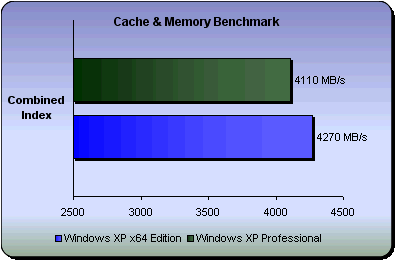
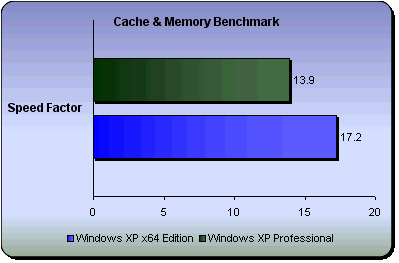
Combined Index: is a composite figure representing
the overall performance rating of the entire Cache-Memory performance in terms
of MB/s. The value is a result of the logarithmic average of all the results
for the entire address space.Here we notice a small lead for windows
XP x64
Speed Factor: Represents the speed differences
between the CPU's cache and memory. The value is a result of the ratio
of the fastest cache (for example L1) bandwidth to the main memory bandwidth,
which means that the lower the result, the better for us. Here we have
Windows XP professional lagging behind by about 20%.
HDD Benchmark
This Benchmark is a composite figure representing an overall performance rating based on the average of the read, write, and seek tests, and file and cache size. It is intended to represent hard disk drive performance under typical use in a PC. A larger number means better performance. The weighting of the results is not equal that it represents the distribution of different files sizes as used on these devices (obtained through field research).
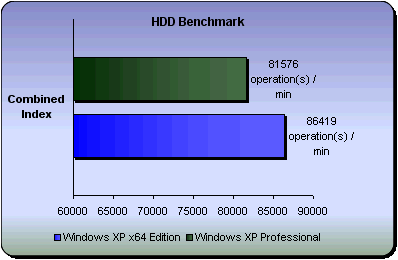
Combined Index: is a composite figure representing
an overall performance rating based on the average of the Combined Index figures
over the four file sizes. This test measures the time that 4 files of the following
size: 512 Bytes, 32KB, 256KB and 2MB can be read, written and deleted (the
number of files per minute). Windows XP x64 shows a performance lead of
about 5000 operations per minute.
18. Application Benchmarks - Science Mark 2
 Science Mark 2.0 is an attempt to put the truth behind benchmarking. In an attempt to model real world demands and performance, SM2 is a suite of high-performance benchmarks that realistically stress system performance without architectural bias. Synthetic benchmarks are useful, and can tell the user valuable performance characteristics about their system's performance, but they should not be used in entirety to measure system performance; this role is reserved in greater part to real applications performing real tasks. Science Mark 2.0 is comprised of 7 benchmarks, each of which measures a different aspect of real world system performance. According to sciencemark.org, the codes in Science Mark 2.0 were architected with general system performance considerations before they were implemented.
Science Mark 2.0 is an attempt to put the truth behind benchmarking. In an attempt to model real world demands and performance, SM2 is a suite of high-performance benchmarks that realistically stress system performance without architectural bias. Synthetic benchmarks are useful, and can tell the user valuable performance characteristics about their system's performance, but they should not be used in entirety to measure system performance; this role is reserved in greater part to real applications performing real tasks. Science Mark 2.0 is comprised of 7 benchmarks, each of which measures a different aspect of real world system performance. According to sciencemark.org, the codes in Science Mark 2.0 were architected with general system performance considerations before they were implemented.
Let's take a more detailed look at each benchmark test and what it does:
"MemBench" - An unbiased, synthetic benchmark that sweeps through more than 15 different, publicly available, memory copy algorithms to measure the peak memory performance of your CPU’s caches and your memory subsystem.
"BlasBench" - Scientists and engineers use large matrix multiplication to determine peak MFLOPS. BlasBench measures the MFLOPS of your machine via large matrix multiplication. The benchmark can be run in single or double precision. Real world matrices are often large and don't fit into the processor's cache. Science Mark 2’s optimized implementations of matrix multiplication in single and double precision, from an algorithm point of view, perform remarkably better than the blind man's matrix multiplication routine. BlasBench uses building blocks called kernels at its lowest level that determine overall MFLOPS performance. These kernels are written in C and a wide assortment of assembly forms (SSE Vector, SSE2 Vector, SSE2 Scalar, x87, 3DNow! Vector) to support any processor architecture in the x86 market.
"MolDyn" - Science Mark 2.0 performs Molecular Dynamics Simulations. It has the flexibility of simulating any 5 noble gases, in 3 different crystallographic configurations, with variable numbers of atoms at a user specified temperature.
"Primordia" - Science Mark 2.0 computes the electronic orbitals for the atoms between Hydrogen and Promethium in the periodic table using a Restricted Hartree-Fock method. Primordia outputs the total all electron energy of the atom in addition to the kinetic and potential contributions. The user is allowed to specify different grids upon which the orbitals are determined.
"QMC" - The Primordia orbitals are utilized to simulate and determine the properties of molecules using the extremely accurate quantum Monte Carlo algorithm. Primordia and QMC are indicative of what is done in commercial chemistry codes on workstations and supercomputers about the world.
"FEM" - The behavior and properties of fluids and structures is modeled using the Finite Element Method. Similar tasks are performed by automotive, aerodynamic and civil engineering companies during their product design.
"Cipher" - Benchmark tests four different forms of encryption algorithms, AES 128/256 bit and RSA 512/1024 bit. Sean's AES 128 bit encryption algorithm is quite possibly the fastest implementation on the face of the earth.
Score is weighted thus:
(((Memory Score + Stream Score) / 2) + Cryptography Score + Molecular Dynamics Score + Primordia Score + BLAS Score) / 5
Unfortunately the final version of ScienceMark 2 for Windows x64 Edition is
still beta. According to the developer, performance may change in the future
depending on how they tune for fp performance. We should see significant
speedups on both EM64T and AMD64 processors in 64-Bit mode. Part of this will
be due to compiler improvements. : Intel EM64T systems are supported, however,
ScienceMark2 won't be able to detect them properly in MemBench at this time.
This will be remedied in a future version. Also, CipherBench
is not supported in 64-Bit mode at this time. This will be remedied in a future
version. The graph below shows us the results of the 32-Bit version of this
program that we ran under Windows XP Professional and the results of the
64-Bit version that we ran under Windows XP Professional x64 Edition.

As we mentioned before, the Cryptography
Benchmark (CipherBench) is not available at this time for the 64-Bit version
of this program. This is the first test where we use a 64-bit version
and we managed to see significant performance increases.
In the molecular Dynamics
Benchmark, notice the awesome performance difference of 49%. We can
understand that this result is due to the fact that in the 64-Bit architecture,
a lot of procedures are completed in less time. Also, in the Primordia
test, we have an increase of 9%.
However, in the BLAS/FLOPs test we
can see that the Windows XP x64 drops to under 35% but if we consider that
this is still a beta program we can expect improvements in a future, stable
release. (The improvements of course will concern improved
scores and not the opposite).
19. Application Benchmarks - Pov-Ray
 The Persistence of Vision Ray-Tracer (Pov-Ray) creates three-dimensional, photo-realistic images using a rendering technique called ray-tracing. It reads in a text file containing information describing the objects and lighting in a scene and generates an image of that scene from the view point of a camera also described in the text file. Ray-tracing is not a fast process by any means, but it produces very high quality images with realistic reflections, shading, perspective and other effects.
The Persistence of Vision Ray-Tracer (Pov-Ray) creates three-dimensional, photo-realistic images using a rendering technique called ray-tracing. It reads in a text file containing information describing the objects and lighting in a scene and generates an image of that scene from the view point of a camera also described in the text file. Ray-tracing is not a fast process by any means, but it produces very high quality images with realistic reflections, shading, perspective and other effects.
What is Ray-Tracing? 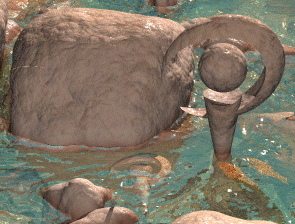
Ray-tracing is a rendering technique that calculates an image of a scene by simulating the way rays of light travel in the real world. However it does its job backwards. In the real world, rays of light are emitted from a light source and illuminate objects. The light reflects off of the objects or passes through transparent objects. This reflected light hits our eyes or perhaps a camera lens. Because the vast majority of rays never hit an observer, it would take forever to trace a scene.
Ray-tracing programs like POV-Ray start with their simulated camera and trace rays backwards out into the scene. The user specifies the location of the camera, light sources, and objects as well as the surface texture properties of objects, their interiors (if transparent) and any atmospheric media such as fog, haze, or fire.
For every pixel in the final image one or more viewing rays are shot from the camera, into the scene to see if it intersects with any of the objects in the scene. These "viewing rays" originate from the viewer, represented by the camera, and pass through the viewing window (representing the final image).
Every time an object is hit, the color of the surface at that point is calculated. For this purpose rays are sent backwards to each light source to determine the amount of light coming from the source. These "shadow rays" are tested to tell whether the surface point lies in shadow or not. If the surface is reflective or transparent new rays are set up and traced in order to determine the contribution of the reflected and refracted light to the final surface color.
Special features like inter-diffuse reflection (radiosity), atmospheric effects and area lights make it necessary to shoot a lot of additional rays into the scene for every pixel.
The below graph displays the time in seconds that the program have to run
in order to complete the test.
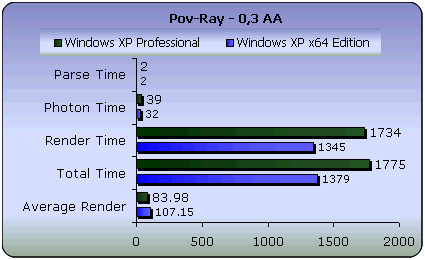
We have also selected this test not only because it is one
of the few available for the 64-bit version, but because we want to examine
the benefits
of the 64-bit architecture regarding rendering images and complex textures
while using effects.
In the test, we selected a resolution of 1280x1024
with an antialiasing threshold value up to 0.3 (to speed up antialiasing,
a threshold
value is
used between pixels. If the difference in color between two pixels is higher
than the threshold, then antialiasing is calculated). Parse time is the time
it takes to parse the project, photon time it takes to render the Photon
map. The photon map is used to render true reflective and refractive caustics
by shooting packets of light (photons) from light sources into the scene.
The Average Render is the average PPS (pixels per second) that the render
took.
With Windows XP x64, rendering was finished 7 minutes
faster (30 minutes for Windows XP Professional and 23 for Windows
XP x64) which makes it 23% faster than Windows XP Professional.
20. Conclusion
Windows XP Professional x64 Edition is an operating system
with a lot of opportunities.
Currently, there aren’t a lot of users that really need this
release, but in the future memory capacities will have reached such high
levels that it will
be necessary. Programmers, web designers, 3D animators to gamers, all
will
need this.
According to Bill Gates, Microsoft is going to continue supporting this operating
system as well as Windows XP (Professional and Home Edition) for another
10 years. This is because Windows XP is the most successful operating system.
Moreover,
a lot of the features of the “Next Generation” operating system
Longhorn, will be made available in the future for the Windows XP and Windows
x64 versions through patches.
Considering this, then it is a very good move to choose to buy this
version over other releases. We still recommend you that if you choose to
install this operating
system, that you create a second partition or install a second hard disk drive
to avoid any problems.
Performance Changes
From our tests, we have come to the conclusion that with the new operating
system, current 32-bit applications (including games) will have a performance
decrease of 1% - 8% although in some special cases there may also be a
performance increase of 5%. The benefits of the 64-bit
architecture
come into their own
with
64-bit
applications
where we managed to see over 49% performance increase and there is still room
for improvement. The ability to simultaneously run more applications than ever
before, makes this release necessary for the power users.
Security and Compatibility
Considering that there are not a lot of antivirus programs available for
this OS at this time, we would suggest you not use this version for surfing
on the
Internet, especially if you have important documents on your machine that you
don't want to lose.
Final words
Microsoft believes that by the end of 2005, all new server class machines
shipping will be 64-bit and at the end of 2006, the majority of new PCs and
workstations will be 64-bit. This is logical if we consider that the price
range will be at the same level as for Windows XP Professional of Home
versions and that there are a lot of 64-bit processors to choose from, so
Windows
XP x64
will
dominate in the end. It is the prelude to what will happen when
Windows Longhorn Final version is released.
We still suggest you install in a separate partition or on another
hard disk drive to avoid compatibility problems, and to check our list for available
drivers and the available
programs that are supported for now. It will take some time before this
will be a 100% safe OS to install, replacing
your older Windows.
Don't forget to take a look at microsoft.com for more information and how
to buy Windows XP Professional x64 Edition.
Discuss this review in our Forum.
21. Drivers Availability
The following list containes all the drivers that are embedded in Windows
XP Professional x64 Edition as they were found in a post from our forum:
Graphics Adapters
(standard display types)
Standard VGA vgapnp.sys (works with onboard ATI Rage XL up to 1280 x 1024 x
24bpp)
(ATI Technologies Inc.)
ALL-IN-WONDER 9600
ALL-IN-WONDER 9700
ALL-IN-WONDER 9800
ALL-IN-WONDER RADEON 9200 LE
ATI FireGL D1100
ATI FireGL D1100 Secondary
ATI FireGL T2
ATI FireGL T2 SEC
ATI FireGL V3100
ATI FireGL V3100 Secondary
ATI FireGL V3200
ATI FireGL V3200 Secondary
ATI FireGL V5100 Secondary
ATI FireGL V5100
ATI FireGL V7100
ATI FireGL V7100 Secondary
ATI FireGL X1
ATI FireGL X1 SEC
ATI FireGL X2
ATI FireGL X2 SEC
ATI FireGL X3-256
ATI FireGL X3-256 Secondary
ATI FireGL Z1
ATI FireGL Z1 SEC
ATI RADEON 9600 Series
ATI RADEON 9600 Series Secondary
RADEON 9000U Family
RADEON 9000U SEC Family
RADEON 9200 LE Family
RADEON 9200 LE SEC Family
RADEON 9200 PRO Family
RADEON 9200 PRO SEC Family
RADEON 9200 SE Family
RADEON 9200 SE SEC Family
RADEON 9500 Family R300 dev 4164
RADEON 9500 Family R350 dev 4169
RADEON 9600 Family
RADEON 9600 PRO Family
RADEON 9600 PRO SEC Family
RADEON 9600 SEC Family
RADEON 9600 TX Family
RADEON 9600 TX SEC Family
RADEON 9700 PRO Family
RADEON 9700 PRO SEC Family
RADEON 9700/9500 SERIES
RADEON 9700/9500 SERIES
RADEON 9800 LE Family
RADEON 9800 LE SEC
RADEON 9800 PRO
RADEON 9800 PRO SEC
RADEON 9800 SE Family
RADEON 9800 SE SEC Family
RADEON 9800 XT
RADEON 9800 XT SEC
RADEON X300 Series
RADEON X300 Series Secondary
RADEON X600 Series
RADEON X600 Series Secondary
RADEON X800
RADEON X800 PRO dev 5549
RADEON X800 PRO dev 4A49
RADEON X800 PRO Secondary dev 5569
RADEON X800 PRO Secondary dev 4A69
RADEON X800 SE dev 554B
RADEON X800 SE dev 4A4A
RADEON X800 SE Secondary dev 556B
RADEON X800 SE Secondary dev 4A6A
RADEON X800 Secondary
RADEON X800 Series dev 5548
RADEON X800 Series dev 4A4C
RADEON X800 Series dev 5568
RADEON X800 Series dev 4A6C
RADEON X800 Series dev 4A68
RADEON X800 XT dev 5D57
RADEON X800 XT dev 4A50
RADEON X800 XT Platinum Edition
RADEON X800 XT Platinum Edition Secondary
RADEON X800 XT Secondary dev 5D77
RADEON X800 XT Secondary dev 4A70
etc...
Buses
USB WIA/PTP/MSC wiawow64.exe/ksthunk.sys/usbstor.sys
All WIA-compliant imaging devices Example : Microtek V6UPL scanner
All PTP-compliant imaging devices Example : Canon PowerShot A60 digital camera
All MSC-compliant imaging devices Example : SanDisk Cruzer Micro thumb drive
Storage
Microsoft RAM Disk
Microsoft RAMDISK Volume
Printers
There are more than 3000 natively supported printers
Epson 600Q ESC/P 2
Epson Action Laser 1000
Epson Action Laser 1100
Epson Action Laser 1400
Epson Action Laser 1500
Epson Action Laser 1600
Epson Action Laser II
Epson Action Laser Plus
Epson AL-1000/1500 Epson Script
Epson AL-1600 EPSONScript
Epson AL-C2000
Epson AL-C2000 PS 3
Epson AL-C8500
Epson AL-C8500 PS3
Epson AP-2000
Epson AP-2250
Epson AP-2500
Epson AP-3000
Epson AP-3250 ESC/P2
Epson AP-3250 Scalable Font
Epson AP-3260 ESC/P 2
Epson AP-3300 ESC/P 2
Epson AP-4000
Epson AP-4500
Epson AP-5000 ESC/P 2
Epson AP-5000 Scalable Font
Epson AP-5000+ ESC/P 2
Epson AP-5500 ESC/P 2
Epson AP-5500 Scalable Font
Epson AP-5500+ ESC/P 2
Epson Compatible 24 Pin
Epson Compatible 9 Pin
Epson DFX-5000
Epson DFX-8000
Epson DFX-8500
Epson DLQ-2000
Epson DLQ-3000 ESC/P 2
Epson DLQ-3000+ ESC/P 2
Epson EPL-3000
EPSON EPL-3000 EpsonScript
Epson EPL-4000
Epson EPL-4100
Epson EPL-4200
Epson EPL-4300
Epson EPL-5000
EPSON EPL-5000/5200 EpsonScript
Epson EPL-5200
Epson EPL-5200+
EPSON EPL-5200+ EpsonScript
Epson EPL-5500
Epson Stylus Color
Epson Photo Stylus 750
The following list is a list with companies that have released drivers for
Windows XP x64 Edition as it was found in our forums.
3Ware
Escalade 7500/8500
download
Adaptec
ATA/ATA RAID
RAID
SCSI/SCSI RAID
Included in OS
ATI Technologies
Graphics Drivers
Radeon Family Desktop
FireGL Workstation Family
Mobility Radeon Family
RageXL Server Family
download
AVM
ISDN Controller
B1 PCI
C2
C4
download
Broadcom (Networking)
Ethernet NIC
57xx family
download
Brother
Printers, Scanners, Fax & Media
HL Series
FAX Series
HJ Series
M Series
MFC Series
P2500 Series
Included with OS
Canon
Printers
BJ Series
BJC Series
ColorPASS Series
GP Series
LBP Series
PS Series
Scanners/Imaging Devices
PS-IPU Color Laser Copier
DV Tape Recorder
DV CamCorder
Included with OS
Conexant
Host Controller Modems
CX11247
CX06834
Controller Base Modems
CX8130
DS56-L144-151
CX06827
CX81801
CX20493
CX11253
Soft Modems
CX11252
CX11256
CX06836
CX11254-31
CX11254-512
CX20468
CX20493
Included in OS
Creative Labs
Sound Blaster Drivers
All Audigy sound cards
All Sound Blaster sound cards
download
Emulex
Fibre Channel
LP8000
LP850
LP9000
LP950
LP9802
LP982
LP8000DC
LP9002L
LP952L
LP9002DC
LP9402DC
LP9802DC
LP1000DC
LP1050
LP101
download
Epson
Printers
AL Series
ActionLaser Series
AP Series
EPL Series
FX, LX, MX, RX Series
LQ, SQ Series
Stylus Series
Included in OS
Scanners
Stylus Color Scan 2000
Expression Series
GT Series
Included in OS
HighPoint
SATA RAID
RocketRAID 1820
download
Hewlett Packard
HP Printers
Business Inkjet series
Color Laserjet series
DesignJet series
Deskjet series
Draftmaster series
Laserjet series
Mopier series
OfficeJet series
PSC series
Included in OS
Lexmark
Lexmark Printers
T Series
C Series
E Series
Optra series
Postscript printers series
Included in OS
Logitech
Gaming devices
Racing Wheels
Game Pads
Joysticks
download
LSI Logic
U320 SCSI Controllers
LSI2x320 series
LSI53c1030 series U320 SCSI RAID HBAs
MegaRAID SCSI 320-x series 2Gig Fibre Channel HBAs
LSI40919x series
LSI44929x series
LSI7x02 series
Included in OS
M-Audio
Audio Cards
Delta Series
Revolution 7.1*
Audiophile 2496
FireWire Series
download
Matrox
Graphics Drivers
G450
G450 eTV
G400 Family
download
NVIDIA
Graphics Drivers
Geforce and TNT2
Quadro
Geforce Go Mobile
download
Chipset Drivers
Nforce3 150
Nforce3 150 Pro
Nforce3 250
Nforce3 250 Pro
download
Promise
Serial ATA controllers
download
QLogic
SANblade QLA23xx Series Fibre Channel
Included in OS
Realtek
Audio
AC?97
6-channel
ALC650
2-channel
ALC250
ALC203
ALC100/P
ALC101
ALC201/A
ALC202/A
download
Gigabit Ethernet
RTL8110SB(L)
RTL8169SB(L)
RTL8110S
RTL8169S
download
10/100 Ethernet
RTL8100C(L)
RTL8100B(L)
RTL8110L
RTL8139C(L)
RTL8139C(L)+
RTL8139D(L)
download
Ricoh
Printers
Included in OS
S2i0
Gigabit Ethernet
Xframe
Included in OS
Silicon Image
Serial ATA controller drivers
download
SIS
Chipset Drivers
755
755FX
760
download
Synaptics
TouchPad
Pointing Sticks
download
VIA
Chipset Drivers
K8T800
K8M800
(VIA Raid contollers may also be extracted from this using WinRAR)
download
22. Programs that are not supported
Last Update: 13-4-2005 (Don't forget to check our forum also.
Notice that the list below is only for the 32-Bit version of the program)
ActiveSync 3.7.1, Microsoft
Acronis true image 8.0
Aquamark3 Benchmark
AVG
BlackICE PC Protection, 3.6.crj
Burn & Go Professional 1.0
CachemanXP
Check Point Enterprise Suite
Daemon tools
Easy CD & DVD Creator 6
Easy CD Creator 5.3.1.154
ESET NOD32 for Windows operating systems
eTrust 7.0
eTrust EZ Antivirus 2005 6.2
McAfee VirusScan 7.02
Napster
Norman Internet Control 5.7
Norman Virus Control 5.7
Norton SystemWorks 2003
Norton Tiny Personal Firewall
Outpost Firewall
Panda
PhotoShop Album 2.0:
PhotoSuite 5.0
PhotoSuite Platinum Edition 7.0
Sygate Personal Firewall
VideoWave Professional 7.0
WMP 10
WordPerfect Family Pack 5
ZoneAlarm Pro 4.5.538 and 4.5.594
Home
|
News
|
All News
|
Reviews
|
Articles
|
Guides
|
Download
|
Expert Area
|
Forum
|
Site Info
Site best viewed at 1024x768+ -
CDRINFO.COM
1998-2024 - All rights reserved
-
Privacy policy
-
Contact Us
.